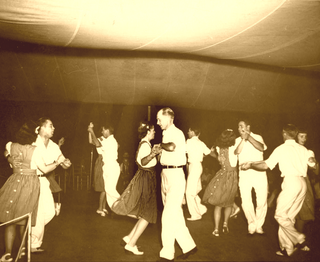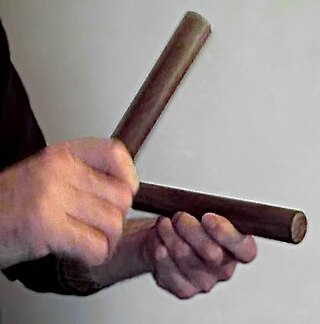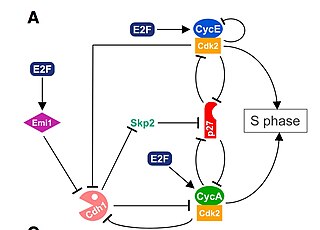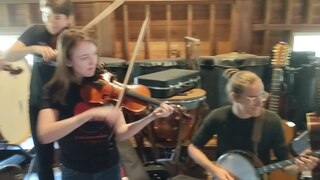
Contra dance is a form of folk dancing made up of long lines of couples. It has mixed origins from English country dance, Scottish country dance, and French dance styles in the 17th century. Sometimes described as New England folk dance or Appalachian folk dance, contra dances can be found around the world, but are most common in the United States, Canada, and other Anglophone countries.

The cell cycle, or cell-division cycle, is the series of events that take place in a cell that causes it to divide into two daughter cells. These events include the duplication of its DNA and some of its organelles, and subsequently the partitioning of its cytoplasm, chromosomes and other components into two daughter cells in a process called cell division.
An alphabetic list of modern country dance terminology:

A country dance is any of a very large number of social dances of a type that originated in the British Isles; it is the repeated execution of a predefined sequence of figures, carefully designed to fit a fixed length of music, performed by a group of people, usually in couples, in one or more sets. The figures involve interaction with your partner and/or with other dancers, usually with a progression so that you dance with everyone in your set. It is common in modern times to have a "caller" who teaches the dance and then calls the figures as you dance. Country dances are done in many different styles.

A square dance is a dance for four couples, or eight dancers in total, arranged in a square, with one couple on each side, facing the middle of the square. Square dances are part of a broad spectrum of dances known by various names: country dances, traditional dances, folk dances, barn dances, ceilidh dances, contra dances, Playford dances, etc. These dances appear in over 100 different formations, of which the Square and the Longways Set are by far the most popular formations.
The polska is a family of music and dance forms shared by the Nordic countries: called polsk in Denmark, polka or polska in Estonia, polska in Sweden and Finland, and by several different names in Norway. Norwegian variants include pols, rundom, springleik, and springar. The polska is almost always seen as a partner dance in, although variants in 2
4 time, as well as in compound meters also exist.

The clave is a rhythmic pattern used as a tool for temporal organization in Brazilian and Cuban music. In Spanish, clave literally means key, clef, code, or keystone. It is present in a variety of genres such as Abakuá music, rumba, conga, son, mambo, salsa, songo, timba and Afro-Cuban jazz. The five-stroke clave pattern represents the structural core of many Cuban rhythms.

The Sydney light rail network is a light rail/tram system serving the city of Sydney, New South Wales, Australia. The network currently consists of three passenger routes, the L1 Dulwich Hill, L2 Randwick and L3 Kingsford lines. The network comprises 42 stops and a system length of 24.7 km (15.3 mi), making it the second largest light rail network in Australia behind the tram network in Melbourne, Victoria. A fourth line, the 12 km (7.5 mi) Parramatta Light Rail in Sydney's west, is currently under construction and planned to open in May 2024.
The Intel Core microarchitecture is a multi-core processor microarchitecture launched by Intel in mid-2006. It is a major evolution over the Yonah, the previous iteration of the P6 microarchitecture series which started in 1995 with Pentium Pro. It also replaced the NetBurst microarchitecture, which suffered from high power consumption and heat intensity due to an inefficient pipeline designed for high clock rate. In early 2004 the new version of NetBurst (Prescott) needed very high power to reach the clocks it needed for competitive performance, making it unsuitable for the shift to dual/multi-core CPUs. On May 7, 2004 Intel confirmed the cancellation of the next NetBurst, Tejas and Jayhawk. Intel had been developing Merom, the 64-bit evolution of the Pentium M, since 2001, and decided to expand it to all market segments, replacing NetBurst in desktop computers and servers. It inherited from Pentium M the choice of a short and efficient pipeline, delivering superior performance despite not reaching the high clocks of NetBurst.
The AMD Family 10h, or K10, is a microprocessor microarchitecture by AMD based on the K8 microarchitecture. The first third-generation Opteron products for servers were launched on September 10, 2007, with the Phenom processors for desktops following and launching on November 11, 2007 as the immediate successors to the K8 series of processors.
In biology and medicine, gravidity and parity are the number of times a female is or has been pregnant (gravidity) and carried the pregnancies to a viable gestational age (parity). These two terms are usually coupled, sometimes with additional terms, to indicate more details of the female's obstetric history. When using these terms:

The G1/S transition is a stage in the cell cycle at the boundary between the G1 phase, in which the cell grows, and the S phase, during which DNA is replicated. It is governed by cell cycle checkpoints to ensure cell cycle integrity and the subsequent S phase can pause in response to improperly or partially replicated DNA. During this transition the cell makes decisions to become quiescent, differentiate, make DNA repairs, or proliferate based on environmental cues and molecular signaling inputs. The G1/S transition occurs late in G1 and the absence or improper application of this highly regulated checkpoint can lead to cellular transformation and disease states such as cancer
Contra dance choreography specifies the dance formation, the figures, and the sequence of those figures in a contra dance. The figures repeat, ideally, in a graceful flowing pattern, aligned with the phrasing of the music. Contra dance figures do not have defined footwork; within the limits of the music and the comfort of their fellow dancers, individuals move to the beat and embellish according to their own taste. Much of the dance is done as a walking movement, one step for each count of the music, while the arms and hands do most of the changing, most of these involving connecting with others' hands.

In popular music, half-time is a type of meter and tempo that alters the rhythmic feel by essentially doubling the tempo resolution or metric division/level in comparison to common-time. Thus, two measures of 4
4 approximate a single measure of 8
8, while a single measure of 4/4 emulates 2/2. Half-time is not to be confused with alla breve or odd time. Though notes usually get the same value relative to the tempo, the way the beats are divided is altered. While much music typically has a backbeat on quarter note (crotchet) beats two and four, half time would increase the interval between backbeats to double, thus making it hit on beats three and seven, or the third beat of each measure :
1 2 3 4 1 2 3 4 1 2 3 4 5 6 7 8 1 2 3 4
Quantum chemistry composite methods are computational chemistry methods that aim for high accuracy by combining the results of several calculations. They combine methods with a high level of theory and a small basis set with methods that employ lower levels of theory with larger basis sets. They are commonly used to calculate thermodynamic quantities such as enthalpies of formation, atomization energies, ionization energies and electron affinities. They aim for chemical accuracy which is usually defined as within 1 kcal/mol of the experimental value. The first systematic model chemistry of this type with broad applicability was called Gaussian-1 (G1) introduced by John Pople. This was quickly replaced by the Gaussian-2 (G2) which has been used extensively. The Gaussian-3 (G3) was introduced later.
Willie Brayshaw Yeadon, was a British railway historian known for his magnum opus, Yeadon's Register of LNER Locomotives and other works.

Lookin At Lucky is a champion American Thoroughbred racehorse who won the 2010 Preakness Stakes. He was the 2009 Champion Two-Year-Old and 2010 Champion Three-Year-Old, becoming the first horse in 32 years to win these awards.
In music, a cross-beat or cross-rhythm is a specific form of polyrhythm. The term cross rhythm was introduced in 1934 by the musicologist Arthur Morris Jones (1889–1980). It refers to a situation where the rhythmic conflict found in polyrhythms is the basis of an entire musical piece.

"Money Musk", alternatively "Monymusk" or other variations, is a contra dance first published in 1786. It was named after a 1776 strathspey by Daniel Dow which is played to accompany it, which itself was named after the House of Monymusk baronial estate. The dance features a central theme of reoriented lines, and is regarded as moderately difficult. It is still widely danced today, and is considered a traditional "chestnut".

The genetic history of the African diaspora is composed of the overall genetic history of the African diaspora, within regions outside of Africa, such as North America, Central America, the Caribbean, South America, Europe, Asia, and Australia; this includes the genetic histories of African Americans, Afro-Canadians, Afro-Caribbeans, Afro-Latinos, Afro-Europeans, Afro-Asians, and African Australians.










